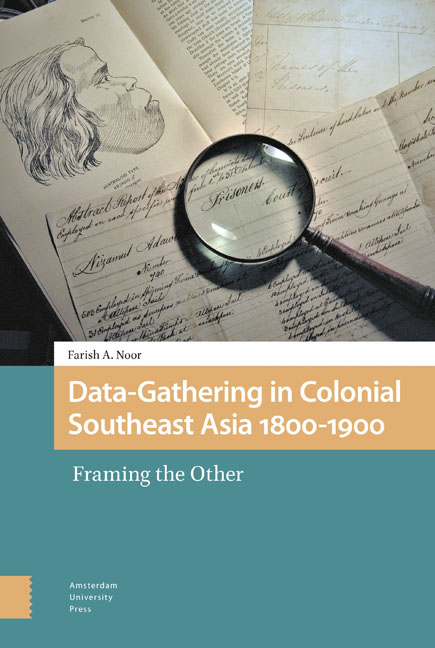Book contents
- Frontmatter
- Dedication
- Contents
- A Note on Spelling
- Introduction: The Panopticon in the Indies: Data-Gathering and the Power of Knowing
- 1 Caught in the Eye of Empire: Stamford Raffles’ 1814 Java Regulations
- 2 Deadly Testimonies: John Crawfurd’s Embassy to the Court of Ava and the Framing of the Burman
- 3 Fairy Tales and Nightmares: Identifying the ‘Good’ Asians and the ‘Bad’ Asians in the Writings of Low St. John
- 4 The Needle of Empire: The Mapping of the Malay in the works of Daly and Clifford
- 5 The Panopticon in the Indies: Data-collecting and the Building of the Colonial State in Southeast Asia
- Appendix A Proclamation of Lord Minto, Governor-General of British India, at Molenvliet, Java, 11 September 1811
- Appendix B Proclamation of Stamford Raffles, Lieutenant-General of Java, At Batavia, Java, 15 October 1813
- Appendix C The Treaty of Peace Concluded at Yandabo
- Appendix D The Treaty of Friendship and Commerce between Her Majesty and the Sultan of Borneo (Brunei). Signed, in the English and Malay Languages, 27 May 1847
- Appendix E The Racial Census employed in British Malaya from 1871 to 1931
- Timeline of Events and Developments in Southeast Asia 1800-1900
- Bibliography
- Index
2 - Deadly Testimonies: John Crawfurd’s Embassy to the Court of Ava and the Framing of the Burman
Published online by Cambridge University Press: 21 November 2020
- Frontmatter
- Dedication
- Contents
- A Note on Spelling
- Introduction: The Panopticon in the Indies: Data-Gathering and the Power of Knowing
- 1 Caught in the Eye of Empire: Stamford Raffles’ 1814 Java Regulations
- 2 Deadly Testimonies: John Crawfurd’s Embassy to the Court of Ava and the Framing of the Burman
- 3 Fairy Tales and Nightmares: Identifying the ‘Good’ Asians and the ‘Bad’ Asians in the Writings of Low St. John
- 4 The Needle of Empire: The Mapping of the Malay in the works of Daly and Clifford
- 5 The Panopticon in the Indies: Data-collecting and the Building of the Colonial State in Southeast Asia
- Appendix A Proclamation of Lord Minto, Governor-General of British India, at Molenvliet, Java, 11 September 1811
- Appendix B Proclamation of Stamford Raffles, Lieutenant-General of Java, At Batavia, Java, 15 October 1813
- Appendix C The Treaty of Peace Concluded at Yandabo
- Appendix D The Treaty of Friendship and Commerce between Her Majesty and the Sultan of Borneo (Brunei). Signed, in the English and Malay Languages, 27 May 1847
- Appendix E The Racial Census employed in British Malaya from 1871 to 1931
- Timeline of Events and Developments in Southeast Asia 1800-1900
- Bibliography
- Index
Summary
The existence of the disabled native is required for the next lie and the next and the next.
Homi K. Bhabha,Articulating the Archaic:Cultural Difference and Colonial Nonsense (1994)Stabbing at the Heart of their Dominions: John Crawfurd's Journal of an Embassy from the Governor-General of India to the Court of Ava
The country was universally cultivated […] (but) the impression left upon the mind of Dr. Wallich and myself, regarding the extent of industry and the amount of inhabitants, was not, however, favourable. There was no bustle, no activity, but a stillness and tranquillity without animation.
John Crawfurd,Journal of an Embassy to the Court of Ava (1829)To say that John Crawfurd (1783-1868) – the East India Company-man and later servant to Lord Hastings and the Anglo-Indian colonial government – had a low opinion of the Burmese people would be an understatement. The fear and distrust of the Asian Other which Bayly (1996) has so vividly described in the workings of British data-collecting and surveillance in India was also evident in the work of Crawfurd, and may have been the result of his own experience in India before he turned to Southeast Asia. The Scottish surgeon-turned-Company functionary had served in India at the start of his career, before moving on to Southeast Asia where he took part in Lord Minto's invasion of Java (and served as the British Resident at the Court of Jogjakarta after the Javanese kingdom had been defeated and its capital ransacked). In 1821 he was sent to Siam and Cochinchina by the colonial authorities in India, and between 1823 to 1826 he was stationed in Singapore, where he helped to build the commercial colony that Raffles had claimed to have founded. Crawfurd would leave Singapore in 1826, and soon after his departure he would be sent off again by the Anglo-Indian government on a mission to the court of Ava in Burma, to negotiate the settlement of the Treaty of Yandabo (see Appendix C) that was signed after Burma's ignominious defeat at the hands of the British forces during the First Anglo-Burmese War of 1824-1826.
- Type
- Chapter
- Information
- Data-Gathering in Colonial Southeast Asia 1800–1900Framing the Other, pp. 69 - 114Publisher: Amsterdam University PressPrint publication year: 2019



